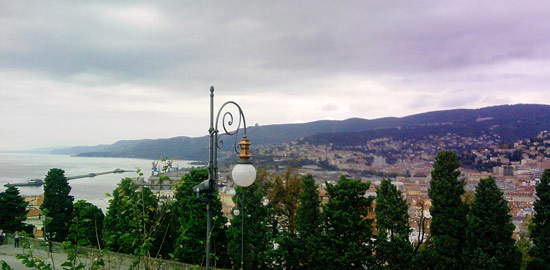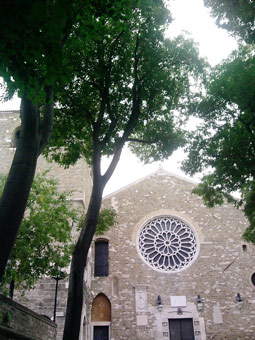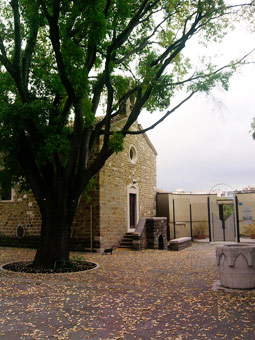There’s little we can do about it: Trieste is a city we really love. And you have probably already noticed: Ilaria, who is hopelessly in love with Trieste, has already talked about it on Finestre Sull’Arte, showing us the Miramare Castle and the San Giusto Castle Museum. And, about Miramare Castle, we had also told you the romantic story of its founder. In this post we return again to the capital of Friuli Venezia Giulia to discover one of its picturesque corners: the hill of San Giusto, with all the wonders it has to offer. Yes, because this is where we find some important symbols of the city!
To visit the San Giusto hill is not only to see one of the, in our opinion, most beautiful places in Italy. In this regard, the view alone would be worth the climb to the hill: there are points from which it is possible to admire the entire city, which will be at your feet, and your gaze will reach as far as the sea and, following the profile of the coast, with its sheer headlands, will be lost beyond the horizon. Well, back to us: visiting the San Giusto hill also means tracing the history of Trieste, from its origins, which are lost in very remote times, to the present day. In short: a compendium of Trieste’s history, all within reach.... view!
 |
| The view from San Giusto hill in Trieste |
Let’s start by saying that the San Giusto hill is the highest point in Trieste, and to get there you have two options. The first, the more convenient one: by car or by public transport, through the avenues that climb up behind the hill. The second, the one that is a bit more tiring, but which will pay off in the end, because it is the most fascinating one: on foot through the old city. We preferred precisely this option, during our stay in Trieste, and of course we suggest it to you as well! Climbing up from the sea, you will have to climb steep paved alleys that wind through old buildings, sometimes turning into stairways, until at a certain point you come to a slightly wider and longer, but still paved, street: it is the street of the Cathedral and will lead you to the top of the hill. Your first “impact” with the hill, if you choose this route, will be precisely the facade of the Cathedral: the church is dedicated, as you can well imagine, to Saint Just, who is the patron saint of the city.
As mentioned, the hill of San Giusto is home to some of Trieste’s landmarks. Beginning with the splendid cathedral, Trieste’s most important church: it is massive and imposing, with its fourteenth-century gabled facade made of stone (but on which a rose window has been grafted to embellish it) flanked by the mighty, squat bell tower, which looks almost like the tower of a castle. If we descend a little on our way to the right (keeping the facade of the cathedral in front of us) we will notice a smaller church: it is San Michele al Carnale, a chapel from the Gothic period, also made of stone. It is notable for its slightly small bell gable tower compared to the body of the building.
 |
| This is how the cathedral presents itself to you arriving from the old city |
 |
| The small church of San Michele al Carnale, close to the cathedral |
But let us now move to the center of the hill. Here we will find the oldest vestiges of the city: in fact, we can easily notice the remains of a very ancient building from the Roman period (we are in the second century BC). There is a stone base, there are columns, some of which still retain their capitals. What we see there, in the center of the square, are the remains of the ancient basilica, one of the most important buildings of the ancient Roman cities (in fact, we have not told you that Trieste, whose earliest settlements even have prehistoric origins, became an important Roman colony: it was then called Tergeste, a name that would perhaps derive from ancient Indo-European dialects and mean “market town”). The basilica, in ancient Rome, was the place where commercial business was conducted and where justice was administered. It was located in the forum, that is, the main square of the city: the one in Trieste was right on top of the hill of San Giusto.
 |
| The remains of the Roman Basilica. In the background is the castle of San Giusto |
As we can clearly see, very little is left of the ancient basilica. This is because the material with which it was built was reused for the construction of the first core of the cathedral: today we see it in its fourteenth-century appearance, but you should know that on the site on which it stands there stood pre-existing buildings of worship, which were built using, precisely, the material of buildings from the Roman era. A fate common to so many monuments of antiquity, that of the reuse of material for more modern constructions. During the Middle Ages, in fact, the hill of San Giusto continued to play an important role for the city. We have already told you that there is an incredible view from up here. Now, we contemporaries see it as a setting for romantic walks. But in ancient times the hill was seen rather as an exceptional checkpoint to see that no attacks were coming from the sea, or simply to see what was going on below. Because of this, the highest point of the hill has always seen the presence of castles, which were then renovated and expanded from era to era. The castle as we see it today (and which is known as, of course, San Giusto Castle) was built in 1470: first here was a medieval fortress built by the Venetians (and which in turn had been built on the site of a Roman fortification, but which had prehistoric origins) that was later torn down to make room for the present castle, the construction of which ended in 1630. Today the castle houses the San Giusto Castle Museum, which Ilaria has already told you about here on Finestre Sull’Arte: for those who want to learn in depth about the history of Trieste, the museum is a must-see!
Again thanks to the Castle, we go through the history of Trieste during the Risorgimento and thus during the irredentist uprisings, since the fortress was also used as a prison for political prisoners, and we arrive until 1918, when the city was annexed toItaly. The castle was still used for military purposes until 1936, when it was finally transformed into a museum. The years of fascism, on the other hand, come to mind if we walk through the Parco della Rimembranza: it is located on the slopes of San Giusto hill and was inaugurated at the very beginning of the Ventennio, in 1926. The stones we find along the way are dedicated to the fallen Trieste citizens during the wars.
San Giusto Hill is a walk through history, art and beauty. A view that makes you dream and takes you all the way to the sea, there in the distance. It is a unique and wonderful place suitable for everyone: for lovers, for friends, for whole families who wish to spend some time in tranquility, discovering a fundamental part of the beautiful city of Trieste. So, if you find yourself staying in Trieste, dedicate the hill the time it deserves; you will not regret it :-)
Warning: the translation into English of the original Italian article was created using automatic tools. We undertake to review all articles, but we do not guarantee the total absence of inaccuracies in the translation due to the program. You can find the original by clicking on the ITA button. If you find any mistake,please contact us.